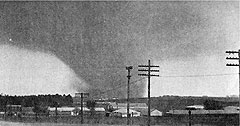 Today marks the 40th anniversary of Iowa’s deadliest tornado outbreak. The storm hit Charles City just before 5 P.M. on May 15th, 1968, and demolished a wide section of the Floyd County town, killing 13 people and injuring more than 460.
Today marks the 40th anniversary of Iowa’s deadliest tornado outbreak. The storm hit Charles City just before 5 P.M. on May 15th, 1968, and demolished a wide section of the Floyd County town, killing 13 people and injuring more than 460.
Jeff Sisson was 12-years-old when the massive twister stuck his hometown. He recalls watching a local cartoon show on a Mason City TV station minutes before the tornado hit.
"We all watched Bart’s Clubhouse after school and I think because Bart did the weather as well, he had a real interest in what happened that day," Sisson says, "we were very, very fortunate because the news that we got on TV and over the radio was well ahead of the times because we had forewarning." He recalls the TV weatherman using a ruler on the map and saying that Charles City was directly in the path of the severe storm.
It was a dangerous thing to do, but Sisson says he went outside to see the storm pass through town. "My father and I actually stood on the porch and watched from the end of Third Avenue," he says. "I can still recall how it looked so eerie down at the west end of Third Avenue and we could see these sticks and things flying around in the air. Later, we realized it wasn’t just sticks and leaves. It was pieces of houses and anything that got picked up was up in the air."
The tornado was classified as an F-5, the strongest possible, with winds as high as 318-miles an hour. From the perspective of a sixth grader, Sisson says the huge storm left a lasting impression on him, as he knew many of the injured and one of the people who died.
"For me, the definition of the term ‘unbelievable’ is a lot different than a lot of people," he says. "If you’ve gone through an F-5 or you’ve seen Hiroshima or if you were around on Nine-Eleven, you have a completely different definition of unbelievable. After growing up in a small town and walking the streets and having friends that lived in those neighborhoods, it just redefined unbelievable for me. You hear people say, ‘That was an unbelievable shot,’ and you think, ‘Nah. That was believable.’ What I saw was unbelievable."
Damage in Charles City was estimated at 30-million dollars. Reporter Brian Ross was another eyewitness. Now a correspondant for A-B-C, Ross’ first television job was at KWWL in Waterloo. That day in 1968, he was assigned to cover the severe weather in Charles City and he made it to town just before the storm hit.
Ross says: "The report from the sheriff was it was heading this way and then suddenly, you could see it coming down the street. I think I was probably the last one to go in for cover because I had a little camera and I had a little tape recorder. I put the tape recorder down to capture the sound — thought it would be there when I got back out." The tape recorder was never seen again.
Ross says they took cover at Charles City radio station KCHA, which had its offices inside an old bank building. "I went down into the vault of the bank with everybody else from the radio station as the storm went over the town," Ross says. "I recall as it passed over, as everyone describes it, the freight train sound was just that. The owner of the station, his ears began to bleed because the pressure dropped so low. There really was a pain from the pressure, and then it was quiet, and we came back and the town was gone."
An unprecedented second F-5 tornado struck Iowa the same day, hitting towns including Oelwein, Fayette and Maynard, killing five people and injuring 156. It damaged or destroyed nearly a-thousand homes and caused 21-million dollars damage.
